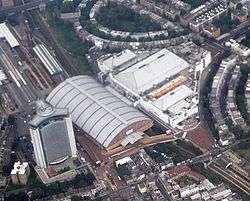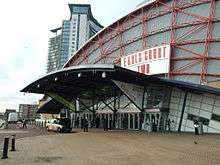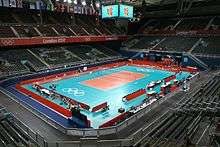Earls Court Exhibition Centre
 Earls Court Exhibition Centre in 2008 | |
| Location |
Kensington, London, SW5 United Kingdom |
|---|---|
| Coordinates | 51°29′20″N 0°11′52″W / 51.48889°N 0.19778°WCoordinates: 51°29′20″N 0°11′52″W / 51.48889°N 0.19778°W |
| Public transit |
|
| Owner | Capital and Counties Plc |
| Capacity | 20,000 |
| Surface | Versatile |
| Construction | |
| Built | 1935–37 |
| Opened | 1 September 1937 |
| Expanded | 1991 |
| Closed | 13 December 2014 |
| Demolished | 2014–16 |
| Architect | C. Howard Crane |
Earls Court Exhibition Centre was an internationally renowned exhibition, conference and events venue in London that originally opened in 1887. Its last art moderne style exterior was built in 1937 and demolished in 2015. Located in Earl's Court within the Royal Borough of Kensington and Chelsea it was the largest such venue within central London. The founder was John R. Whitley and the first exhibition included performances by Buffalo Bill Cody as part of the 'American Exhibition'. This was followed by 'Four National Exhibitions', the title of C. Lowe's 1892 book about Earls Court and its founder.
Earl's Court was widely known for serving as London's premier exhibition hall for many decades, hosting the Royal Tournament and Earl's Court Motor Show, Ideal Home Show, the Brit Awards (until 2010), Crufts Dog Show and a number of other notable events and concerts. It was also used as one of the venues for both the 1948 and 2012 Olympic Games. It was served by two London Underground stations: Earl's Court and West Brompton, opposite its entrances on Warwick Road and Old Brompton Road respectively.
In 2013 plans to demolish Earls Court were approved in order to make way for a new residential and retail estate on the site, which is expected to be completed in 2033. Demolition work began on the site in December 2014.
Construction

Before 1887 Earl's Court was farm land attached to Earls Court Manor. With the arrival of a multiplicity of railway companies, and before London Underground became distinct from the cross country railways, the tracks formed a triangle which became 'waste ground'. The introduction of two Underground stations, and a mass network of rails trapped the land. The idea of introducing entertainment to the area was brought about by John Robinson Whitley, an entrepreneur who used the land as a show-ground for a few years from 1887. Whitley did not profit from his efforts, yet his desire had decided the future of Earl's Court and its purpose in later years. In 1895 the Great Wheel, a huge Ferris wheel, was created for Imre Kiralfy's 'Empire of India Exhibition'. A plaque in the press centre commemorates some of these facts and that Queen Victoria was a frequent visitor to the shows. Kiralfy had built Earl's Court in the style of the 1893 Chicago White City for the Columbian Exposition, and went on to found nearby White City in 1908.
In 1935, Earls Court was sold and the new owners decided to construct a show centre to rival any other in the world and to dominate the nearby Olympia exhibition hall. The plan was to create Europe's largest structure by volume. The project did not go exactly to plan; it ran over budget and was late in completion. Designed by architect C. Howard Crane with over 40,000 sq m of space over two levels, Earls Court finally opened its doors to the public for the Chocolate and Confectionery Exhibition on 1 September 1937.[1] The Earl's Court Motor Show immediately followed and later the Commercial Vehicle show. In spite of all the problems during the latter part of its construction, the project was eventually completed at a cost of £1.5 million.
Following the construction of Earl's Court Two, this original building became known sometimes as Earl's Court One.
Earls Court Two
 Entrance to Earls Court Two, 2009 | |
| Location |
Kensington, London, SW5 United Kingdom |
|---|---|
| Owner | Capital and Counties Plc |
| Capacity | 10,750 or 6,000 (seated) |
| Construction | |
| Opened | 17 October 1991 |
| Closed | 13 December 2014 |
| Demolished | 2015 |
In response to the drastic need to increase exhibition space, Earls Court Two was constructed at a cost of £100 million. The barrel-roofed hall links with Earls Court One and the hall's 17,000 sq m floor was entirely column-free. The hall was opened by Princess Diana on 17 October 1991 for the Motorfair.
Earls Court Two was demolished by Capco Plc in 2015. It was situated on land originally occupied by a mass of sheds linked to the Lillie Bridge Engineering and Railway Depot.
Events

Exhibitions
Earls Court hosted many shows and exhibitions throughout the years, including the Earl's Court Motor Show the Ideal Home Show and the BRIT Awards. The MPH Show, one of Britain's largest motoring exhibitions and shows, hosted by Jeremy Clarkson and others, took place there each winter after an earlier showing at the National Exhibition Centre in Birmingham. Each summer from 1950 to 1999 Earls Court was home to the Royal Tournament, the first, oldest and biggest military tattoo in the world. For this the area now occupied by Earls Court Two became a stables, artillery and vehicle depot for some two months, with several hundred military personnel from all three services billeted 'on site'.
Notable historic exhibitions at the centre include:
- The American Show, 1887.
- The Italian Exhibition in London, 1888.
- The Spanish Exhibition, 1889.
- French Exhibition, 1890.
- German Exhibition, 1891.
- Captain Boynton's Water Show, 1893.
- Empire of India Exhibition, 1895.
- Empire of India & Ceylon Exhibition, 1896.
- International Universal Exhibition, 1898.
- Greater Britain Exhibition, 1899.
- Paris in London, 1902.
- International Fire Exhibition, 1903.
- Balkan States Exhibition, 1907.
- Old Japan, 1907.
- Shakespeare's England, 1912.
The central area of the main hall concealed a massive pool area, formerly used for the London Boat Show before that transferred to ExCeL in the London Docks. It was also briefly used for the Earls Court Boat Show. The floor was supported on a combination of hydraulic jacks with lock-in rigid supports, enabling it to be used in its 'up position' for 'heavyweight' events such as the Royal Tournament, then lowered and flooded to give a 60 m long and 30 m wide pool between 2.5 m and 3 m deep (depending on usage). The 750-ton concrete exhibition floor could be removed and reinstated at the push of a button. When used it took four days to fill and four days to empty and 2¼ million gallons of water were needed to fill it. These operations could only be accomplished at night, so as not to put undue strain on local services.
The Professional Lighting and Sound Association held its annual trade show, the PLASA Show, at Earl's Court between 1992 and 2012. The 2013 show was held at ExCeL.
London Film and Comic Con was hosted at Earl's Court 2, held every July. The convention held autograph and photoshoot sessions with celebrity guests as well as providing a place to play games and buy collectables. In July 2014, due to the increase in the event's popularity, it was hosted in both Earl's Court 1 and Earl's Court 2.
War refugees camp
During the First World War, Earl's Court Exhibition Centre turned into a huge refugee camp of the British Government. From 15 October 1914 onwards until 1919, more than 100,000 Belgian refugees stayed in this camp.[2]
Sport

Earls Court hosted the volleyball competitions in the 2012 Summer Olympics. The volleyball events were scheduled for the multi-sport arenas in the Olympic Park.[3] At the 1948 Summer Olympics, the venue hosted the boxing preliminaries, gymnastics, weightlifting, and wrestling events.[4]
The London leg of the 2010 FIFA World Cup Trophy Tour was held at Earl's Court Two on 11 March, with Wayne Rooney making an appearance with the trophy.
Musical events
Earl's Court was one of the most popular arenas to play in the UK, with a capacity of around 19,000 including standing room, meaning it was often chosen over other venues by bands with a large fan base. Slade[5] and David Bowie[6] were the very first rock acts to play there in 1973. However, after the opening of the O2 Arena concert performances at Earl's Court were rarer. On 28–31 May, 1 June 2002, Irish vocal pop band Westlife held concerts for their World of Our Own Tour supporting their album World of Our Own.
Pink Floyd seating collapse, 1994
On the night of 12 October 1994, Pink Floyd were scheduled to begin a 14-night residency of the Centre as part of their Division Bell world tour. During their opening song, "Shine On You Crazy Diamond"[7] a section of seating, containing 1,200 attendees, collapsed, injuring 90 people.[8] There were no deaths.[8] The show was immediately cancelled and re-scheduled for 17 October.[8][7]
Brit Awards
The Brit Awards, the British Phonographic Industry's annual pop music awards, were first held at Earl's Court in 1997 and then from 2000 to 2010. The awards show moved to the O2 Arena in 2011.[9] The name was originally a shortened form of "British", "Britain" or "Britannia", but subsequently became a backronym for British Record Industry Trust.[10]
Dog Show
Before moving to the Birmingham NEC, Crufts Dog show was held here annually. With public and Kennel club concerns about the neglect and mistreatment of dogs, it introduced an annual exhibition aimed at showing how best to look after dogs as pets or care companions. This was Discover Dogs. The last show in London was held in 2014.
Demolition and redevelopment
The owner of Earls Court and Olympia, Capital & Counties Properties (also known as Capco), opened discussions in 2010 with the London Borough of Hammersmith & Fulham and the Royal Borough of Kensington & Chelsea to demolish the existing landmark centre and redevelop the area with up to 8,000 residential flats, retail outlets and possibly a new convention centre.[11][12][13]
Demolition work began on the site in December 2014.
Opposition to demolition
The demolition of Earl's Court was opposed by the Save Earl's Court Action Group.[14] The group was composed of local residents and interested parties who would be affected by the exhibition centre's destruction and subsequent 20 years of proposed redevelopment.
Nicky Gavron, a Labour Party member of the London Assembly, argued that "losing Earl's Court would be a huge setback for the London and UK economy. Earl's Court brings in £1bn a year, provides a shop window for UK industries and sustains thousands of long-term jobs in the local area. This economic benefit cannot and will not be replaced by a one-off construction project. There is no evidence London needs less exhibition space. Britain's competitors are currently expanding their own capacity because they understand the economic benefits these centres create."
Darren Johnson, a Green Party member of the London Assembly, wrote to the Mayor of London, Boris Johnson, and argued that "the Earl's Court demolition plans are a recipe for a disaster, with massive economic, social and environmental consequences. The winners will be the wealthy developers who will leave the houses empty and overseas property speculators while the losers will be the community, local businesses and Londoners who will lose one of the capital's key exhibition centres."[15]
The Guardian's London blogger Dave Hill cited concerns over the number and relative affordability of the housing units that will be constructed on the site after the proposed demolition of Earl's Court, as well as concerns over the views of local residents.[16]
Despite the opposition, Boris Johnson approved the redevelopment plans on 3 July 2013.[17]
References
- ↑ "The final curtain for Earls Court: last gig at legendary music venue". London Evening Standard. 12 December 2014.
- ↑ Belgian Refugees 1914-1918, website of Amsab-Instituut voor Sociale Geschiedenis, Ghent, Belgium Archived 17 August 2017 at the Wayback Machine.
- ↑ London2012.com profile. Archived 2 October 2011 at the Wayback Machine. – accessed 29 September 2010.
- ↑ 1948 Summer Olympics official report. Archived 16 July 2011 at the Wayback Machine. pp. 43, 46, 49–50.
- ↑ http://www.sladeinengland.co.uk/Press/live%20reviews/Slade%20Earls%20Court%20Charlsworth%201973.htm
- ↑ https://www.davidbowie.com/blog/2018/5/12/bowie-at-earls-court-45-years-ago
- 1 2 "Pink Floyd - 1994 Earls Court seating collapse report". Brain Damage magazine. Retrieved 15 March 2018.
- 1 2 3 Penman, Danny (13 October 1994). "Pink Floyd 'very angry and upset' over accident: Human error could have caused temporary stand's collapse at rock concert attended by 15,000 fans". The Independent. Retrieved 15 March 2018.
- ↑
- ↑ BRITs Duo On Track To Reach Dizzee-ing Heights in UK Charts British Recorded Music Industry Retrieved 28 April 2011
- ↑ yourearlscourt.com Archived 16 January 2010 at the Wayback Machine.
- ↑ Carmichael, Sri (22 January 2010). "On the Bill: Earls Court Demolished To Make Way for 8,000 Flats". London Evening Standard. Archived from the original on 26 January 2012. Retrieved 7 August 2012.
- ↑ (registration required) Hatcher, David (19 June 2009). "Olympian Effort". Property Week. Retrieved 5 August 2012.
- ↑ "Save Earl's Court! – Home". Saveearlscourt.com. Retrieved 15 January 2014.
- ↑ "News from Darren Johnson AM: Mayor urged to refuse Earl's Court planning application | Greater London Authority". London.gov.uk. 5 March 2013. Archived from the original on 23 April 2013. Retrieved 15 January 2014.
- ↑ Hill, Dave (26 November 2012). "Earls Court: Kensington and Chelsea's go ahead can't hide the contradictions". The Guardian. Retrieved 15 January 2014.
- ↑ "Earls Court demolition plan approved by Mayor of London". BBC News. 3 July 2013. Retrieved 4 July 2013.
External links
| Wikimedia Commons has media related to Earls Court Exhibition Centre. |
| Preceded by Crown of Beauty Theatre Sanya |
Miss World Venue 2011 |
Succeeded by Dongsheng Fitness Center Stadium Ordos City |


_pictogram.svg.png)
_pictogram.svg.png)

